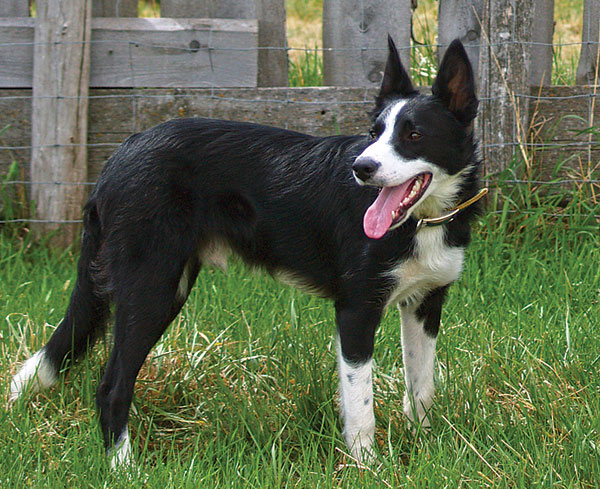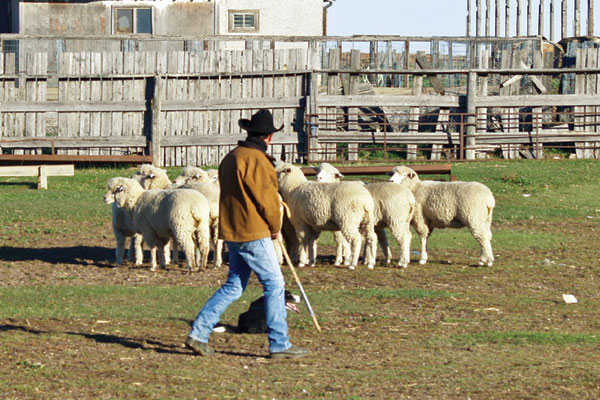Bonus Article: Problem Solving and Trouble Shooting

After receiving a number of questions from readers, we decided to do one last article on problem solving and trouble shooting. Although there are many more problems that can arise, these are a few of the questions I have been asked.
My dog will get on the head of a cow and just spin her around and won’t let her go. How do I fix this problem?This is quite common with a strong heading dog and must be corrected from the start.
In a loud, gruff voice, tell him to “get back” or “get out.” It’s okay if he has to come to the head of a cow to make her move, but then he must fall back in behind the cow to keep pressure on from behind. This tendency of a dog staying on the head of a cow can be frustrating and hard to correct, but if nipped in the bud soon enough and consistently enough, and if the dog is listening, it can be fixed. Actually, this kind of dog, once he learns how to handle and put pressure on a cow properly, is very good at moving cattle calmly, quietly and confidently.
When driving stock and giving my dog an inside flank, say from 5 o’clock to 7 o’clock, he always wants to flank behind me. How do I get him to flank between me and the stock so he stays in contact with them?
In the fifth article, I talked about “driving” and inside flanks, but didn’t have space or room to mention one of the main problems that can occur. Which is; with some dogs if he can’t flank behind you, he won’t flank at all.
Dogs are creatures of habit, and they don’t have to repeat a certain maneuver too many times until it becomes a habit. Remember, at the start of training you have the dog circling and going to balance.
Then you are making him change directions, putting side commands on him. All the while, you are staying close to the stock, and making the dog stay out. In making the dog stay out and off the stock, he will be going around on the outside of you. With some dogs, this can get to be a very ingrained habit. Even though they may know their side commands fairly well, they simply refuse to cross in front of you.
One thing you can do is; get yourself backed up to a fence so the dog can’t run between you and the fence. Say you are trying to flank him from 5 o’clock to 7 o’clock. You walk in the clockwise direction along the fence. Make the dog come towards you with a “come bye” or “come here.” As he tries to get behind you, don’t let him squeeze between you and the fence. Eventually you should be able to encourage him to cross in front of you.
If he still refuses to cross in front of you, try moving out well away from the fence. Again, flank or call the dog towards you (come bye). Before he can pass behind you, lie him down gently. (If you’re too harsh at this point, he’ll want to get out more.) Now, calmly and quietly, you step behind the dog and over to the other side of him, making him stay where he is. Now he is in front of you and your position will encourage him to go on to his left. After you do this a few times or maybe quite a few times, he will be more comfortable and learn to cross in front of you.
Do you like a heading dog or heeling dog to work cattle?
Ideally it’s great if a dog will bite both ends, but it’s been my experience that most dogs prefer one end or the other. Personally, I prefer a good, strong heading dog over a heeling dog. A good, strong heading dog will always have control of the cattle and if handled right, can put the cattle anywhere you want them.
A lot of good heeling dogs don’t have the nerve to stand in front of a cow and turn her. Consequently, the cow will go where she wants to with the dog biting at her heels.
When I say a heading dog, I don’t mean one that will just dance around in front of a cow and bark or “shadow box.” I mean one that will stand his ground, calmly and confidently, nose to nose and nip the cow on the nose, just to turn her and then ease off and let her go.
That’s how you “dog break” cattle and it’s a very important aspect of working cattle with a dog. I call this the “hot wire effect” — in the same way cows learn to avoid an electric fence. They might put their nose on a hot wire once to check it out. Maybe twice, but when they get zapped or bit again, they learn to avoid the wire, and in the same way, the dog.
Every rancher who plans to use a dog to handle his cattle should make it a priority to get his cattle “dog broke.” If you keep replacement heifers, you have two years to work them before they have a calf on them. In the winter when they are being fed, take a few minutes as often as you can and move them around with the dog. Even the older cows; work them in the winter when they don’t have calves on them. Don’t wait until they have baby calves on them to introduce them to a dog. Any good mother cow is going to protect her baby from a predator, but if she is “dog wise” beforehand, and the dog doesn’t over-pressure or harass her, she will likely pick up her calf and move off.

My dog leaves some animals behind instead of bringing them all. What do I do?
This is quite common and needs to be addressed early and aggressively. This is one situation that, in my opinion, you can correct the dog severely and really make him think about what he is doing. When the dog leaves stock behind, you can use this situation to teach the command “Look Back” on your dog.
When he leaves stock behind, go at the dog very aggressively and threateningly, telling him in a harsh voice to “Look Back!”
With a lot of dogs, this tendency of leaving animals behind can be avoided if properly started from the very beginning. In the early stages of training, make sure he stays out wide enough on his outrun and gets to 12 o’clock before turning in on the stock. Don’t let him turn in on the stock at 11 o’clock or 1 o’clock. This is very important.
As you progress in the dog’s training, don’t increase the length of his outrun too fast. Make sure he’s 100 per cent correct at going 50 yards before sending him 100 yards. If you increase the distance you send him gradually, making sure he’s doing it right all along, it won’t be long before he’s going hundreds of yards and picks up everything.
If he persists on leaving something back, just keep scolding him and sending him back. When he does go back and gets them all, give him some praise. Remember, the vast majority of these dogs want to please you. They don’t lay awake at night trying to think of ways to cheat you or disobey you. For a little praise, they will try to do almost anything for you and if you are not pleased with what they’re doing, they will know it. If you are happy, they are happy. That’s why they are known as Man’s Best Friend.
Final Thoughts
With this being the last article in this series, I’d like to thank the staff of Canadian Cowboy Country magazine and especially Terri Mason who encouraged me to write these columns in the first place. Also, Terri would proofread them. She’s not a dog person (she does have a cat trained to meow when it wants food) and if she understood what I was trying to explain in a limited number of words, we went with it.
I enjoyed writing them and hope you found them helpful. Even more, I hope a few dogs will have a more useful and enjoyable life because of them.
I want to close with these words from John Holmes, author of The Farmer’s Dog:
“No animal, certainly no person, is willing to do so much in return for so little as the farmer’s or shepherd’s dog. There is no National Union of Agricultural Dogs to argue their case within the National Farmers Union. Remember, therefore, that your dog not only belongs to you, he depends on you for everything. All he wants is a comfortable bed, some decent food and a master who understands him. Surely that is not too much to give in return for all he does for you. And if he does not do exactly what you want, make sure, before blaming him, that you are not to blame yourself.”












